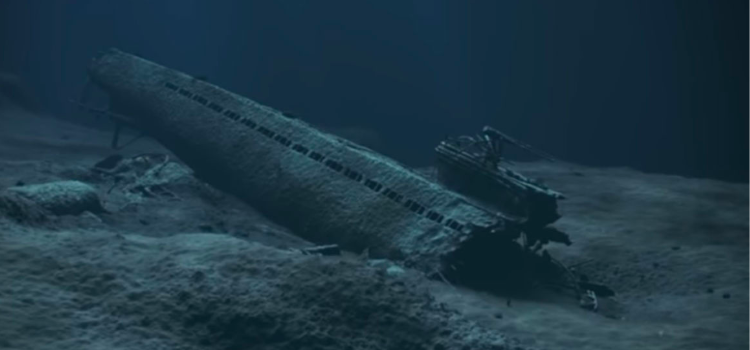America has 50 attack submarines in active service designed to tail and destroy enemy submarines and surface ships. China and Russia have dozens more. Strangely enough, only one submarine battle has been fought underwater in over 100 years of modern submarine warfare — it was a World War II action that saw a British sub with limited firepower attack a much larger German adversary.

Captured German U-boats sit after the war. The one on the right is a Type IX similar to U-864.
(Imperial War Museums)
The fight took place in 1945, near the end of the war. British intelligence intercepted communications about Operation Caesar, an attempt by Germany to send advanced technology to Japan, helping it stay in the war and, hopefully, buying the Axis a few more months to turn everything around.
The Germans had loaded prototypes and advanced weapon designs as well as German and Japanese scientists onto U-864 with massive amounts of liquid mercury for transport to Japan. Some of the most exciting pieces of technology onboard were jet engines from German manufacturers.
Corvette Capt. Rolf-Reimar Wolfram, commander of U-864.
Operation Caesar was launched on Dec. 5, 1944, under the command of Corvette Capt. Ralf-Reimar Wolfram. His rank is the equivalent of a U.S. lieutenant commander or major — fairly junior for such an important mission.
His initial plan was solid. The Allies controlled much of the water he would have to transit, and the beginning was the most dangerous. Britain had solid control of the North Sea, so Wolfram decided to stick to the coast and allow German shore installations to protect him.
“Tallboy” and “Grand Slam” earthquake bombs penetrated the surface of the Earth and detonated underground, channeling most of their power through the rock and broke structures like submarine pens, canals, roads, and other targets.
(Imperial War Museums)
Unfortunately for him, he grounded his sub while going through the Kiel Canal and had to head to drydock for repairs. While the boat was being repaired at Bergen, Norway, an attack by British planes dropping “earthquake bombs” damaged the pen and the sub, further delaying the mission.
This delay would prove fatal. Britain had intercepted early communications about the mission, and the delay gave them a chance to send a British submarine to intercept the German one. The HMS Venturer was sent to Fedje, Norway.
Venturer was a fast attack submarine, quick, but with a smaller crew and armament than its enemy. It could fire four torpedoes at once and had a total inventory of eight torpedoes to U-864’s 22.
(Imperial War Museums)
The British sub, under command of Lt. James S. Launders, moved into position on Feb. 6, 1945. Launders was a distinguished sub commander with 13 kills to his name, including the destruction of a surfaced German submarine. The technological challenges he was facing would still be daunting, though.
The Venturer had only two methods of finding an enemy sub, hydrophones or active sonar. The active sonar would give away his position, but the hydrophones had a limited range. And the boat’s torpedoes were designed to attack ships on the surface.
Worse for Launders and his crew, by the time he arrived, Wolfram and U-864 had already passed their position. The German sub was safely beyond the British position.
But then the German sub’s diesel engines began to misfire. Wolfram had a decision: press forward with his mission and risk engine trouble or failure while sailing north past the Baltic countries and Russia and through the Arctic Circle, or double back for additional repairs.
Out of an abundance of caution, Wolfram headed back to Bergen, taking him right through Launders’ trap.
On February 9, the British crew was monitoring their hydrophones when the misfiring diesel engine on the German sub gave away its position. Launders had his sub stealthily move to the source of the noise where he first saw an open ocean, a sign that the engine noise was coming from underwater.
Then, he saw what he suspected was an enemy periscope, likely the German subs snorkel mast that allowed it to run its diesel engines while shallowly submerged. Launders knew he had his target in front of him.
The Venturer tailed the U-864 for the next few hours. U-864 began taking evasive actions, a sign that it had likely detected the British presence.
The British, running low on battery power, decided to put all their eggs in one basket, attacking with two salvos of four torpedoes. The first salvo was “ripple-fired,” with each torpedo launch coming about 18 seconds after the previous one.
The British sub dove and began re-loading its four tubes. Again, the British fired all four. Of the eight torpedoes, seven were complete misses.
One was a direct hit. The British hydrophone operators heard the torpedo impact, the explosion, the wrenching of iron as the pressure crumpled it like paper, and the dull thud as the wreckage crashed to the sea floor.
The site was undisturbed for almost 60 years until the Norwegian Navy discovered it in 2003. Mercury was leaking from damaged vials, and Norwegian authorities decided to bury the wreck under tons of sand and rocks to prevent further damage to the ecosystem.
This article originally appeared on We Are The Mighty
More From We Are The Mighty
5 Reasons Why Troops Stick Together After the Military
4 Reasons Why Showering On Deployment is Disgusting
7 of the Greatest Songs Every Veteran Knows
6 Things You’d Take Back Before Leaving the Military
6 Dumb Things Veterans Lie About on the Internet
Follow We Are The Mighty on Twitter
READ NEXT: BEWARE OF THE MARINE-TURNED-NIGERIAN-PRINCE SCAM






